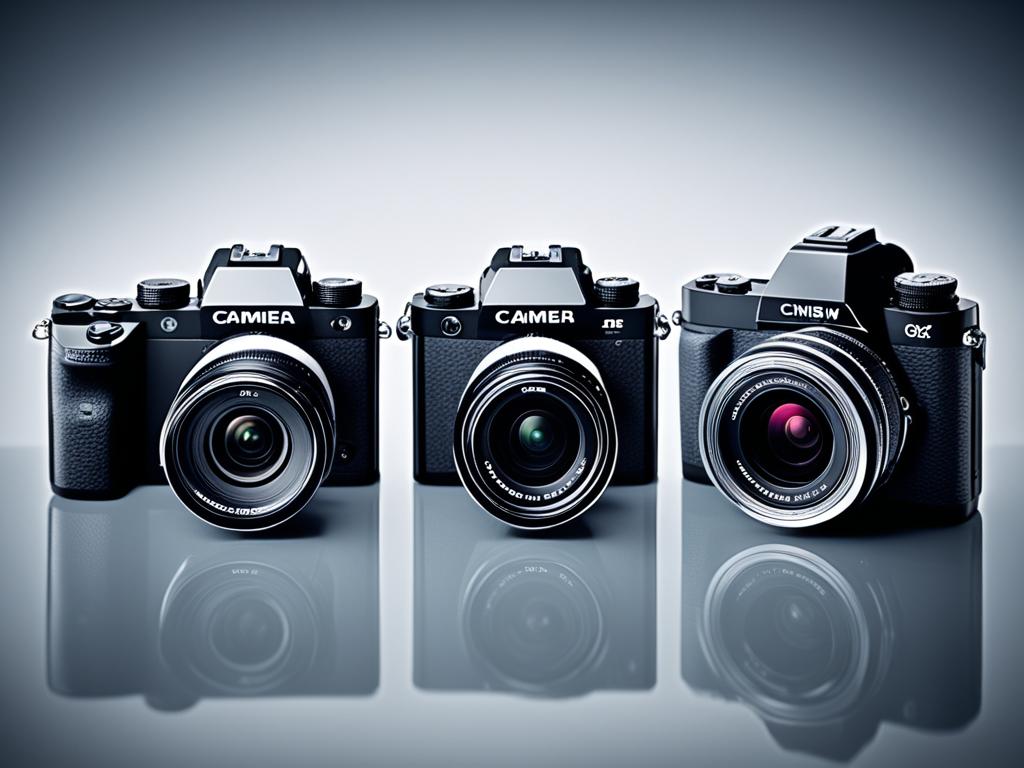Welcome to the fascinating world of photography, where innovation and technology have revolutionized the way we capture and share moments. In this article, we will take you on a journey through the evolution of photography, from its humble beginnings in film to the digital age and the advent of mirrorless cameras.
Photography has come a long way since the days of film. The embrace of digital technology has forever changed the way we take photos, opening up new creative possibilities and making photography accessible to everyone with a smartphone in their pocket. And now, mirrorless cameras are pushing the boundaries further, combining the best of both worlds – exceptional image quality and compact design.
Join us as we delve into the different eras of photography, explore their unique characteristics, and discover the remarkable advancements that have shaped the art of capturing light. From the tactile experience of film photography to the convenience of digital cameras, and now the cutting-edge mirrorless technology, each era has its own allure and significance.
Key Takeaways:
- Film photography marked the beginning of photography’s journey, with analog cameras and darkroom processing.
- The rise of digital photography brought about DSLR cameras and image sensors, revolutionizing the industry.
- Mirrorless cameras offer the perfect blend of high image quality and portability with interchangeable lenses and compact designs.
- Film photography has made a comeback in the digital age, with photographers embracing hybrid shooting and film simulations.
- Smartphone photography has become mainstream, thanks to the advancements in camera phones and mobile editing apps.
The Era of Film Photography
Welcome to the captivating world of film photography, where photographers embraced the marvels of analog cameras and the meticulous process of darkroom processing. During this era, the artistry of capturing moments on film and the anticipation of developing them lent a unique charm to photography.
Analog cameras, such as the iconic Nikon F3 and the versatile Canon AE-1, were the tools of choice for photographers exploring the world of film. These cameras offered manual control over settings, allowing photographers to master the craft and achieve their desired results.
Darkroom processing added another layer of artistry to film photography. The photographer would carefully develop the exposed film, bringing to life the images captured with precision and care. The process involved bathing the film in chemicals, adjusting exposure times, and carefully printing each image on photographic paper.
“Film photography allows you to slow down, to really think about each shot. The process of developing your images in the darkroom is magical, and it gives you a deeper connection to your work.” – Rebecca Thompson, film photographer
Unique Aesthetics and Challenges
Film photography has a distinct aesthetic that digital photography often seeks to replicate. The rich colors, subtle grain, and unique tonal range of film create a nostalgic and artistic feel that can’t be replicated with digital filters alone.
This era of photography also presented its fair share of challenges. Film photographers had to carefully consider each shot before pressing the shutter button, as every frame had a cost in terms of film, processing, and time. The limited number of exposures per roll demanded precision and intentionality in capturing moments.
Additionally, the darkroom process required a combination of technical skill and artistic sensibility. Developing films and prints demanded careful attention to detail, accurate exposure, and precise timing.
Pushing the Boundaries
Despite the numerous challenges, film photography enthusiasts continuously pushed the boundaries of the medium. Experimentation with different film stocks, exposure techniques, and darkroom manipulation allowed photographers to create unique and extraordinary images that reflected their vision and artistic expression.
| Advantages | Disadvantages |
|---|---|
|
|
While digital photography has become the dominant medium in recent years, the allure of film photography remains. In the next section, we will explore the digital revolution, which forever changed the landscape of photography.
The Digital Revolution
Witness the transformation brought about by digital photography. In the ever-evolving world of visual artistry, this technological breakthrough has revolutionized the way we capture and preserve moments forever.
At the heart of this revolution lies the advent of DSLR cameras, an innovation that changed the game for professionals and enthusiasts alike. These powerful devices combine advanced optics, manual controls, and the ability to interchange lenses, allowing photographers to unleash their creative vision like never before.
“The introduction of DSLR cameras marked a turning point in the history of photography. Suddenly, photographers had unprecedented control over the entire image-making process, from composition to post-processing.”
Essential to this digital transformation is the use of image sensors to capture and store images in a digital format. These sensors act as the electronic equivalent of film, converting light into electrical signals that form the foundation of the digital image.
The utilization of image sensors brought numerous benefits over traditional film photography. Photographers gained the ability to immediately review their shots, adjust settings on the fly, and experiment with a wide range of post-processing techniques, all without the need for time-consuming development and darkroom processing.
Unleashing Creativity with DSLR Cameras and Image Sensors
DSLR cameras, enabled by the power of image sensors, offered photographers groundbreaking possibilities to explore their creativity:
- Unmatched Image Quality: The combination of high-resolution image sensors and advanced optics deliver exceptional clarity, dynamic range, and color reproduction. Each frame becomes a masterpiece, every detail captured in stunning precision.
- Versatile Lens Options: The interchangeable lens system of DSLRs allows photographers to select the perfect lens for any situation. From wide-angle landscapes to telephoto portraits, the ability to swap lenses opens up a world of artistic possibilities.
- Control and Customization: DSLRs put the power of manual controls in your hands. Adjust aperture, shutter speed, and ISO to create desired effects and capture the perfect shot in any lighting condition. Dive into the depths of creative expression with every click.
- Post-processing Possibilities: Digital photography offers endless post-processing opportunities. Manipulate contrast, saturation, and apply creative filters to enhance your images and bring your artistic vision to life.
Embrace the digital revolution in photography, where the marriage of digital photography, DSLR cameras, and image sensors opens up boundless opportunities to capture and express your unique vision.
| DSLR Cameras | Image Sensors |
|---|---|
|
|
Experience the power of digital photography for yourself. Embrace the limitless potential of DSLR cameras and image sensors, and unleash your creativity with every click.
Mirrorless Cameras: Combining Quality and Portability
Experience the cutting-edge technology of mirrorless cameras, a game-changer in the world of photography. These innovative devices bring together the image quality of DSLRs with the convenience and compactness of traditional point-and-shoot cameras. Whether you’re a professional photographer or an enthusiast, mirrorless cameras offer a versatile and powerful tool for capturing stunning images.
One of the standout features of mirrorless cameras is their interchangeable lens system. With a wide range of lenses available, you have the flexibility to choose the perfect lens for each shot, whether it’s capturing breathtaking landscapes or zooming in on distant subjects. From wide-angle to telephoto, macro to portrait lenses, you can unleash your creativity and capture the world from different perspectives.
Not only do mirrorless cameras offer exceptional image quality, but their compact design makes them incredibly portable. Gone are the days of carrying heavy camera equipment. With a mirrorless camera, you can enjoy the freedom to explore and capture moments without being weighed down by bulky gear. Whether you’re traveling, attending events, or simply enjoying a weekend stroll, your mirrorless camera will be your trusty companion, ready to capture every memorable moment.
The Advantages of Mirrorless Cameras
Let’s take a closer look at some of the advantages of mirrorless cameras:
- Compact Size: Mirrorless cameras are significantly smaller and lighter than DSLRs, making them more convenient to carry and use in various shooting scenarios.
- Fast Autofocus: Mirrorless cameras utilize advanced autofocus systems that are incredibly fast and accurate, ensuring sharp and precise images.
- Electronic Viewfinder: Unlike DSLRs that use an optical viewfinder, mirrorless cameras feature an electronic viewfinder (EVF) that gives you a real-time preview of the image before you capture it, helping you make precise adjustments.
- Silent Shooting: Mirrorless cameras operate silently, making them ideal for capturing discreet moments without disturbing the subject.
- Video Capabilities: Many mirrorless cameras offer impressive video recording capabilities, allowing you to shoot high-quality videos with ease.
With the advancements in technology, mirrorless cameras have become a top choice for photographers worldwide. Their combination of superior image quality, portability, and versatility make them an irresistible option for capturing stunning visuals in any setting.
| Mirrorless Cameras | Interchangeable Lenses | Compact Design |
|---|---|---|
| High image quality | Wide range of lens options | Lightweight and portable |
| Fast autofocus | Zoom, wide-angle, telephoto, and more | Perfect for travel and on-the-go photography |
| Electronic viewfinder for precise framing | Compatibility with different focal lengths | Easy to handle and operate |
The Revival of Film Photography in the Digital Age
As we enter the digital age, there has been a surprising resurgence of interest in film photography. While digital cameras and smartphone photography have dominated the market, many photographers and enthusiasts are rediscovering the charm and nostalgia of shooting on film.
One of the reasons behind this film photography revival is the desire for a unique and distinctive aesthetic that can’t be easily replicated with digital images. Film captures light in a different way, resulting in a more organic and timeless feel. Photographers are embracing film simulations, which allow them to recreate the characteristics of different types of film in their digital workflow.
These film simulations help photographers achieve the desired look and feel without the need for extensive post-processing. With the digital advancements in post-production software, hybrid shooters are able to seamlessly blend the best of both film and digital worlds.
Hybrid shooters, as they are known, are photographers who embrace both film and digital formats. They use film cameras to capture certain moments or achieve specific artistic goals and then utilize digital technology for editing and sharing. This hybrid approach allows for greater flexibility and creative control, enabling photographers to experiment with different styles and techniques.
“Film photography offers a tangible and tactile experience that digital cannot replicate. The process of shooting on film forces you to slow down and be more deliberate with your composition and exposure.” – Emma Thompson, professional photographer
Furthermore, film photography has a certain allure and sentimental value that resonates with photographers and their clients. The physicality of holding a film negative or a printed photograph can evoke a deeper emotional connection and a sense of nostalgia.
With the film photography revival, there has also been a renewed interest in film cameras, both new and vintage. Many photographers appreciate the craftsmanship and attention to detail in analog cameras, and they enjoy the challenge and skill required to master the art of film photography.
The Benefits of Film Photography Revival
The revival of film photography brings several benefits to photographers and enthusiasts:
- Unique aesthetics: Film photography offers a distinct look and feel that cannot be replicated with digital images.
- Artistic exploration: Film simulations and hybrid shooting allow photographers to explore new styles and techniques.
- Emotional connection: The physicality of film photographs creates a deeper emotional connection for both photographers and viewers.
- Skill development: Mastering film photography requires a deeper understanding of composition, exposure, and manual techniques.
- Nostalgia and sentimentality: Film photography carries a sense of nostalgia and sentimentality that resonates with many.
As the digital age progresses, the revival of film photography reminds us of the importance of preserving and honoring the traditions and artistry of the past. Whether shooting on film or embracing hybrid approaches, photographers are finding new ways to capture the world around them and create lasting visual memories.
Photography in the Age of Smartphones
Welcome to the exciting era of smartphone photography where the power to capture and share images is right at your fingertips. Camera phones have revolutionized the way we document our lives, allowing us to capture memorable moments anytime, anywhere. With advancements in technology, these pocket-sized devices have become powerful tools for photographers of all skill levels.
Smartphone photography has democratized the art form, enabling anyone with a phone to explore their creativity and express themselves visually. Gone are the days when you needed expensive equipment to take stunning photos; now, all you need is your smartphone and a keen eye.
“The best camera is the one that’s with you.” – Chase Jarvis
Mobile phones have evolved from simply capturing snapshots to producing high-quality images. The integration of advanced camera sensors, sophisticated lenses, and image processing algorithms has propelled smartphone photography to new heights. Today’s camera phones boast impressive resolutions, dynamic range, and low-light performance, rivaling many dedicated cameras.
But it’s not just the hardware that has improved; the advent of mobile editing apps has transformed the way we enhance and refine our smartphone photos. With a wide range of editing tools and filters available at your fingertips, you can transform an ordinary shot into a work of art. Whether you want to adjust exposure, add creative effects, or fine-tune colors, these apps provide endless possibilities for unleashing your creativity.
The rise of social media platforms has also played a significant role in shaping smartphone photography. The ease of sharing photos instantly with friends, family, and even the world has made photography more accessible and interactive. It has created a vibrant community of photographers who inspire and learn from one another, fostering a sense of connection and collaboration.
Empowering Creativity on the Go
One of the key advantages of smartphone photography is its portability. Unlike traditional camera setups, you can carry your camera phone in your pocket or bag, ready to capture spontaneous moments and unexpected scenes. This accessibility allows for more improvisation, experimentation, and the chance to capture authentic, candid shots that might have been missed otherwise.
Furthermore, the compact nature of smartphone cameras allows you to blend in with your surroundings, making it easier to capture candid street photography or immersive travel shots without drawing unnecessary attention.
The Future of Smartphone Photography
As smartphone technology continues to advance at a rapid pace, we can expect to see even more exciting developments in the world of smartphone photography. From camera phones with multiple lenses and enhanced zoom capabilities to artificial intelligence-powered features that assist in capturing the perfect shot, the possibilities are endless.
Moreover, as mobile editing apps become more sophisticated, we can anticipate an even greater level of control and creativity in post-processing. These apps will continue to empower photographers to push the boundaries of their imagination and create visually stunning images.
Conclusion
The evolution of photography has taken us on a remarkable journey from the traditional film era to the digital age, and now to the era of mirrorless cameras. Throughout this transformative journey, we have witnessed significant advancements, trends, and challenges in each era.
The digital age brought about a revolution in photography, with the introduction of DSLR cameras and the ability to capture and store images digitally. This new era empowered photographers with instant feedback, improved image quality, and unprecedented creative possibilities.
Today, mirrorless cameras have emerged as a game-changer, combining the image quality of DSLRs with the portability of compact cameras. With their interchangeable lenses and sleek designs, mirrorless systems offer photographers a new level of flexibility and convenience.
Furthermore, we cannot overlook the impact of smartphone photography in shaping the way we capture and share moments. Camera phones have become powerful tools, supported by advanced technology and mobile editing apps, allowing anyone to unleash their creativity and share their vision with the world.
The evolution of photography is a testament to the constant innovation and adaptability of this art form. From film to digital to mirrorless, each era has brought its own set of challenges and opportunities. As technology continues to advance, it is important for photographers to embrace new technologies and trends, while still appreciating the unique aesthetics and nostalgia of film photography. So, go ahead, pick up your camera, whether it’s digital or film, or simply use your smartphone, and capture the magic of the world around you.







